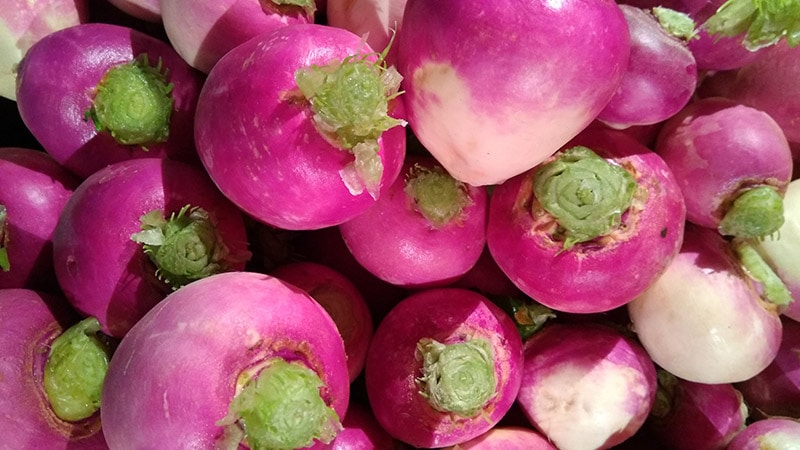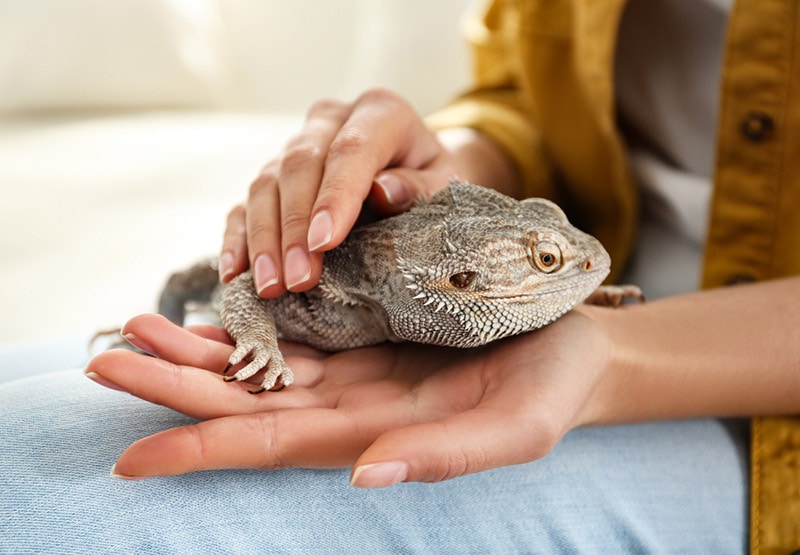Can Bearded Dragons Eat Turnips? Vet-Approved Diet, Nutrition, & FAQ
By Ed Malaker
Updated on

Click to Skip Ahead
Bearded dragons are popular reptiles to keep as pets. They are fun to watch and relatively easy to maintain once you have their habitat set up. However, their diet can be confusing, and one of the foods that many people wonder about is turnips. Fortunately, turnips are safe to give to your pet in moderation, but keep reading as we list the pros and cons of this vegetable and provide tips about other healthy options.
The Bearded Dragon Diet
Bearded dragons are omnivores that consume plant matter and small insects. As adults they eat more plant material and as a rough guide their diet should consist of approximately 70% vegetables, 20% insects, and 10% fruits. A well-rounded diet will ensure that your bearded dragon receives the necessary vitamins, minerals, and fiber for optimal health. It will also help prevent metabolic bone disease, which is common in bearded dragons that don’t get enough calcium, vitamin D3 or UV-B light. It results in a softening of the bones, which can limit movement and shorten their lifespan.

Nutritional Value of Turnips
Turnip greens contain a large amount of water, which can help keep your pet hydrated. They also have a good calcium-to-phosphorus ratio and are among the recommended foods for bearded dragons, according to VCA Animal Hospitals. These greens can be a staple part of your pet’s diet. The red-and-white turnip root contains vitamins C and E and plenty of fiber, and it is also safe for your pet to eat in moderation as a treat. It is slightly acidic and less healthy than the greens because the calcium-to-phosphorus ratio isn’t as good and doesn’t contain as many nutrients. However, it can be a great way to add variety to the bearded dragons’ diet and get them excited about eating.
Turnip and Turnip Greens Comparison Chart
| Turnip Greens (1 cu.) | Turnips (1 cu.) | |
| Calcium (mg) | 104.5 | 39 |
| Phosphorus (mg) | 23.1 | 35.1 |
| Calcium-Phosphorus Ratio | 4.5–1 | 1.1–1 |
| Protein | 0.825 | 1.2 |
Preparing Vegetables for Bearded Dragons
Proper preparation is essential when feeding turnips or any other vegetables to bearded dragons. Wash them thoroughly to remove pesticides or contaminants, and chop or shred the vegetables into small, manageable pieces. Bearded dragons have small mouths and can struggle with large chunks of food, leading to a choking hazard. You can also lightly steam or blanche the vegetables to increase digestibility, but raw is fine if the pieces are small enough.

How Often Can I Feed Turnips to My Bearded Dragon?
While turnip roots are not suitable to be a regular part of a bearded dragon’s diet like the greens are, you can offer them as occasional treats. Moderation is essential, though, and turnips should never replace calcium-rich vegetables and those with a better calcium-to-phosphorus ratio that will help prevent the onset of metabolic bone disease. If you offer turnips to your beardie, ensure that they are mashed or cut into small pieces to improve digestibility. However, it is always best to consult a reptile veterinarian before introducing new food to your bearded dragon’s diet. It’s also a good idea to watch them carefully after feeding them something new, looking for signs of discomfort or digestive problems.
Alternative Vegetables for Bearded Dragons
Leafy greens like collard, mustard, and dandelion greens are excellent choices due to their high calcium content. Other safe vegetables include butternut squash, bell peppers, broccoli, carrots, cabbage, cucumber, radish, and green beans. Providing a variety of vegetables can help ensure a diverse nutrient profile.
Frequently Asked Questions
Can Turnips Cause Any Health Problems for Bearded Dragons?
When fed regularly and in large quantities, turnips can contribute to calcium deficiency in bearded dragons due to their high phosphorus content. This imbalance can lead to metabolic bone disease, a condition that weakens the bones and can result in fractures. It is important to prioritize calcium-rich foods in your beardie’s diet and offer turnips as occasional treats.
Are There Any Other Vegetables That I Should Avoid Feeding to My Bearded Dragon?
Certain vegetables should be avoided or only fed in moderation to bearded dragons. These include vegetables with high oxalate content, such as spinach and beet greens, as these can bind with calcium and interfere with absorption. Additionally, vegetables like iceberg lettuce have little nutritional value. Focusing on calcium-rich vegetables and offering various options to ensure a balanced diet is best.
What Are the Signs of Calcium Deficiency in Bearded Dragons?
Signs of calcium deficiency or metabolic bone disease in bearded dragons can include soft or rubbery bones, limb or spine deformities, difficulty walking, lethargy, tremors, and fractures. If you notice any of these signs or are otherwise concerned about your pet’s health, it is important to seek veterinary care. A reptile veterinarian can diagnose and provide appropriate treatment.
How Often Should I Offer Turnips as Treats?
Turnips should be offered only as occasional treats to bearded dragons due to their imbalanced calcium-to-phosphorus ratio. It is best to prioritize other calcium-rich vegetables in their diet, like turnip greens.
Summary
Turnips can make nice treats for your bearded dragon and will help add variety to their diet, but they aren’t as healthy as turnip greens and don’t have an ideal calcium-to-phosphorus ratio, so it’s better to provide them only occasionally. They are also slightly acidic and can upset your pet’s digestive system, so it is important to watch your beardie carefully after feeding them to ensure that no problems develop. To feed turnips to your bearded dragon, wash them carefully to remove contaminants, and cut them into small pieces or mash them to make them easier to consume.
See also:
- Can Bearded Dragons Eat Grass? Vet-Approved Facts, Diet, & Risks
- Can Bearded Dragons Eat Edamame? Vet-Reviewed Facts & Tips
Featured Image Credit: JumpStory













